Abstract
Ketoconazole, an antifungal drug, completely inhibited the growth of Candida albicans 7N at concentrations of greater than or equal to 50 microgram/ml (94 microM). However, ketoconazole incompletely inhibited the growth of this opportunistic yeast at concentrations of 25 to 0.2 microgram/ml (47 to 0.4 microM). At these lower concentrations, 2,3,5-triphenyl tetrazolium chloride, an electron acceptor, was reduced by several strains of C. albicans. This effect resulted in red coloration of colonies. Concomitantly, this phenomenon was not antagonized in the presence of ergosterol. Furthermore, neither ketoconazole nor antimycin A inhibited the growth of C. albicans under anaerobic conditions, as revealed by a paper disk method. Ketoconazole at the concentrations stated above inhibited endogenous and exogenous respiration immediately after it was added to a system containing log phase C. albicans cells, as determined polarographically. At the same time, ketoconazole inhibited the activity of NADH oxidase at the mitochondrial level. In contrast, higher concentrations of ketoconazole (greater than 100 microM) were required to inhibit the activity of succinate oxidase from rat liver mitochondria. In addition, concentrations of ketoconazole greater than 100 microM were required to impair the uptake of labeled leucine and adenine and, subsequently, the incorporation of the former into protein and the latter into DNA and RNA in intact cells. On the other hand, ketoconazole at concentrations of 10, 1.0, and 0.4 microM had no effect on either membrane permeability or macromolecular synthesis.
Full text
PDF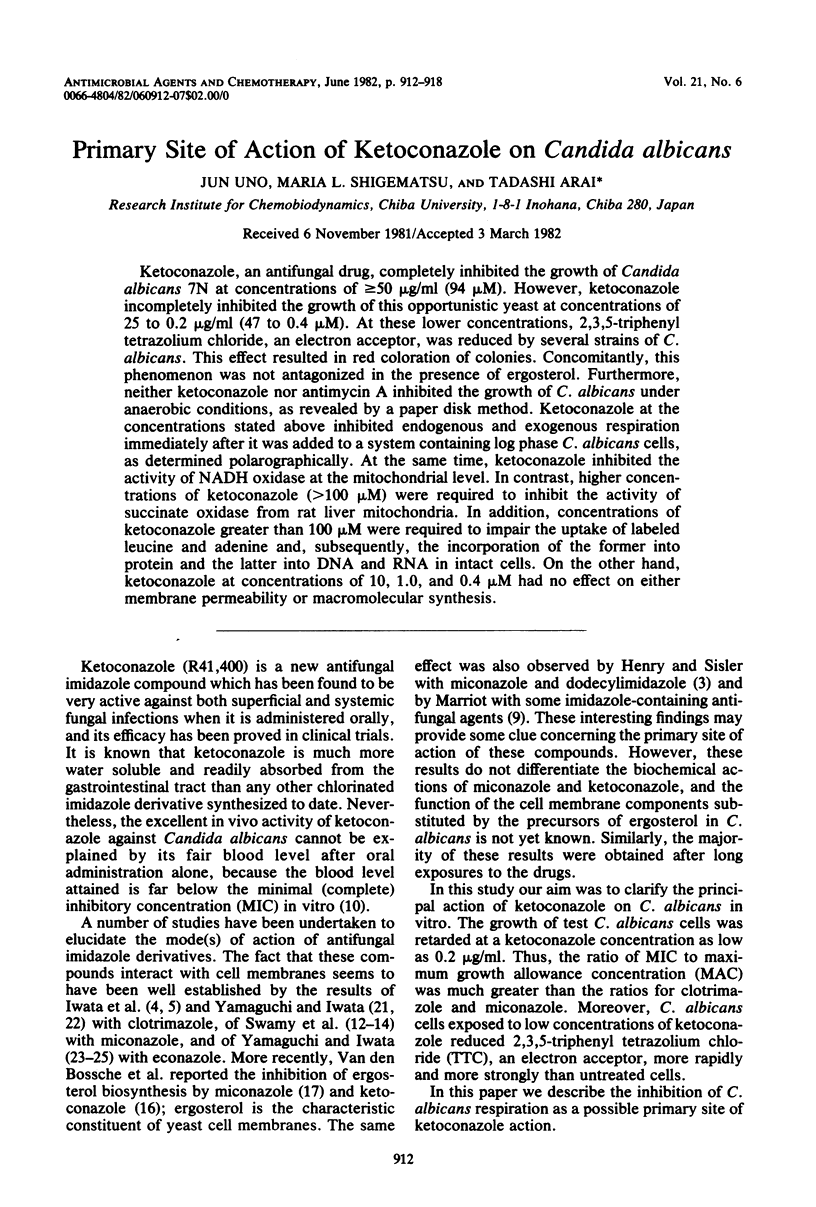
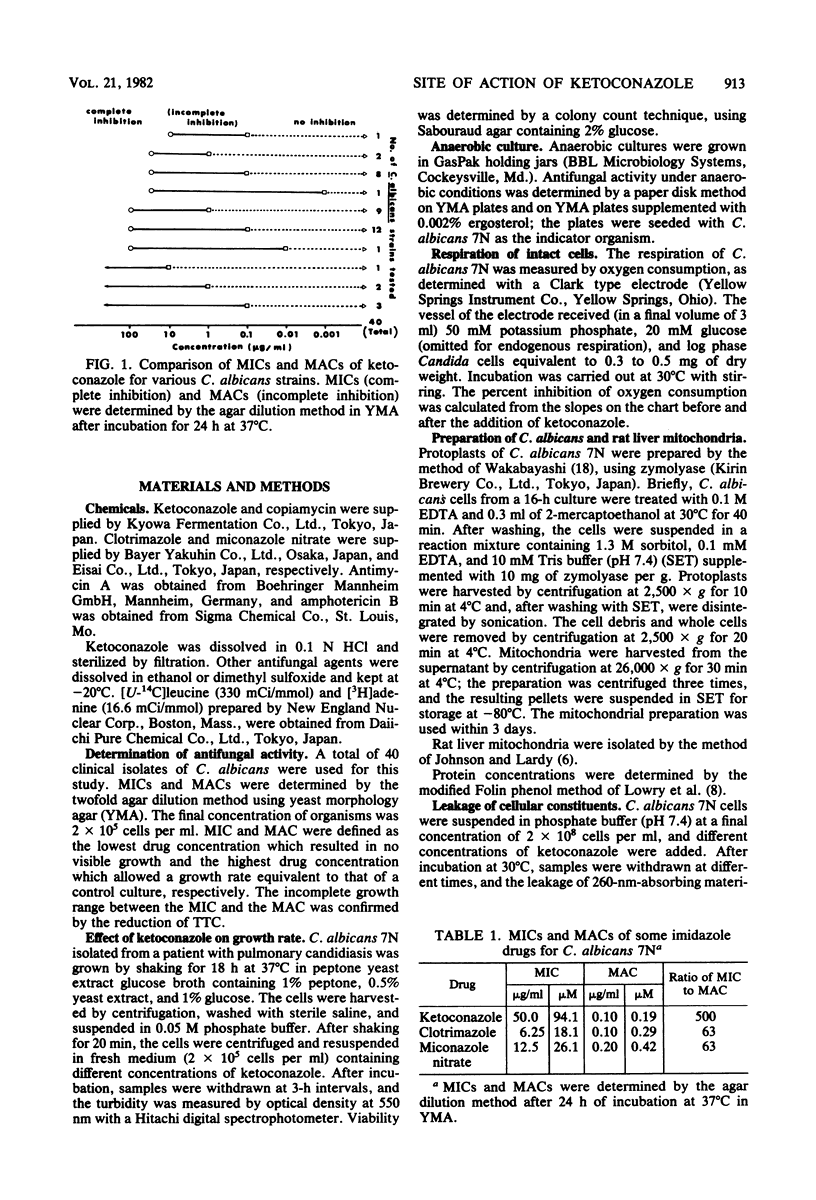
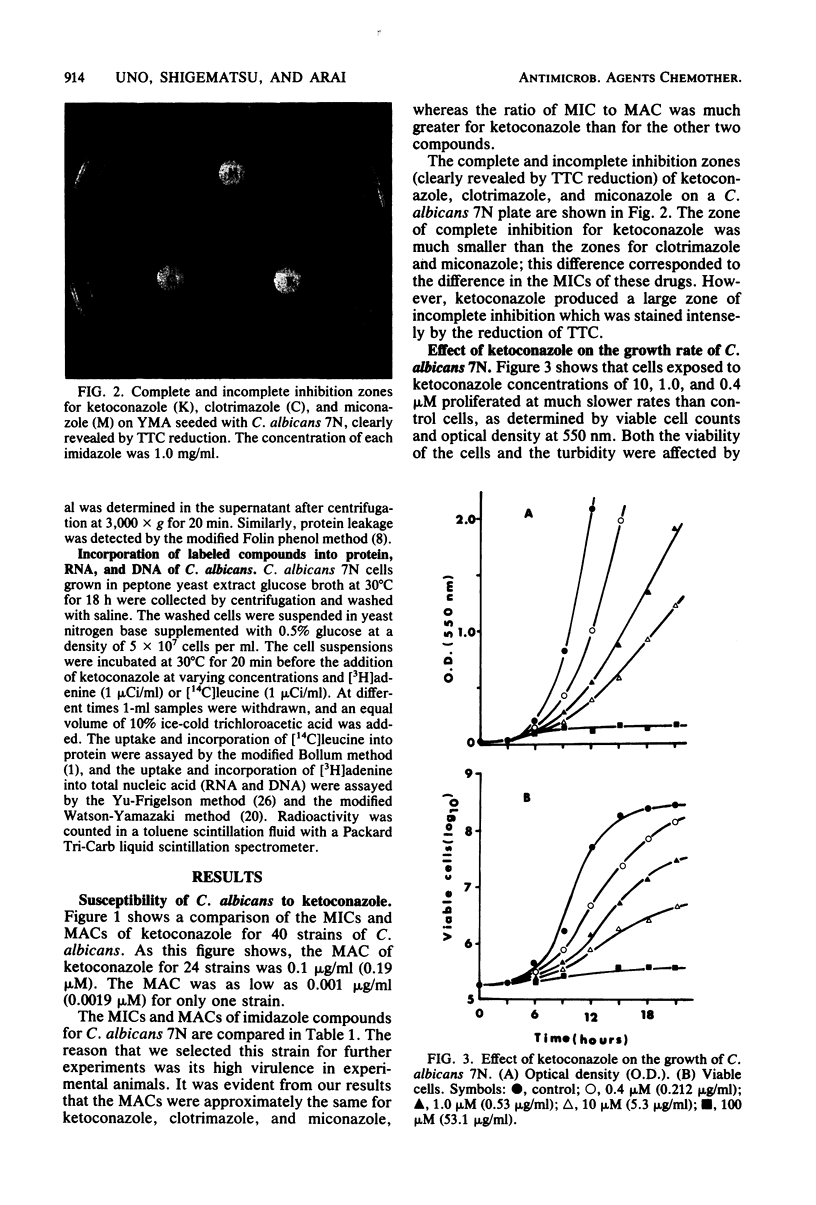

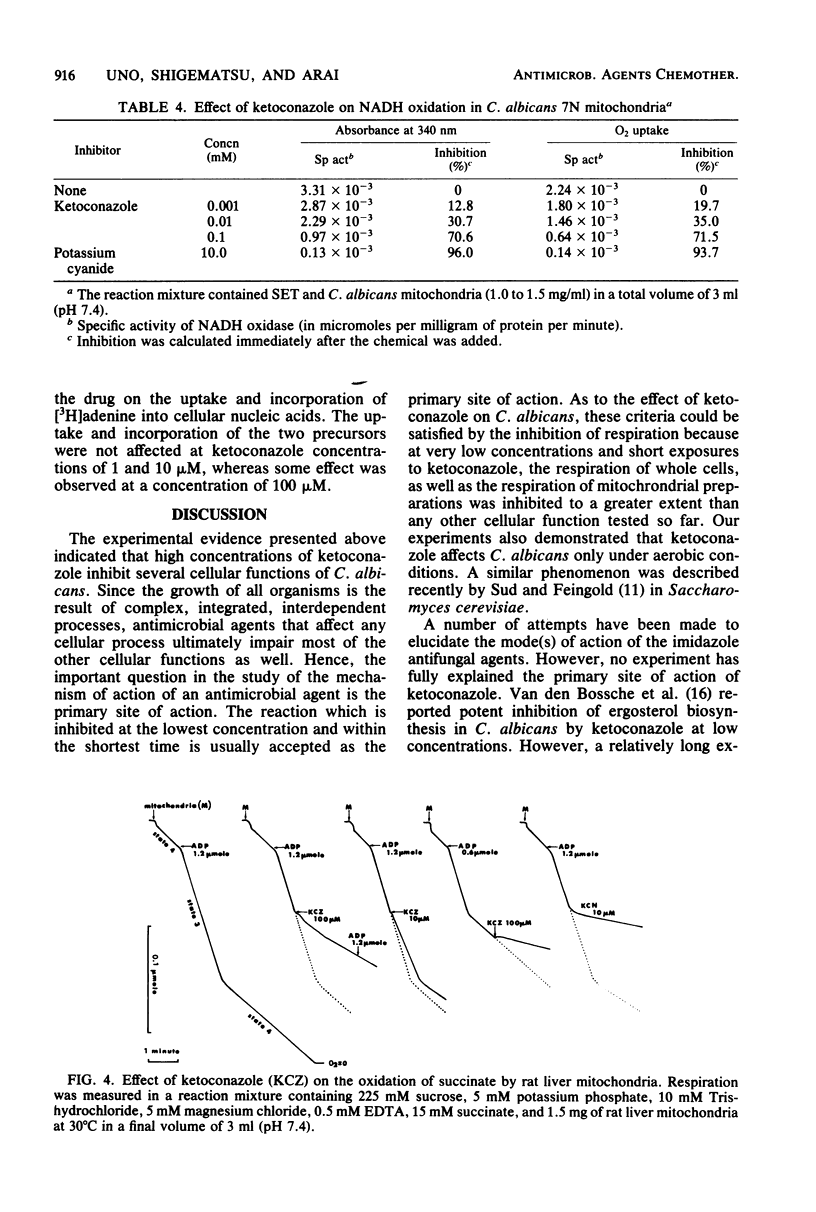
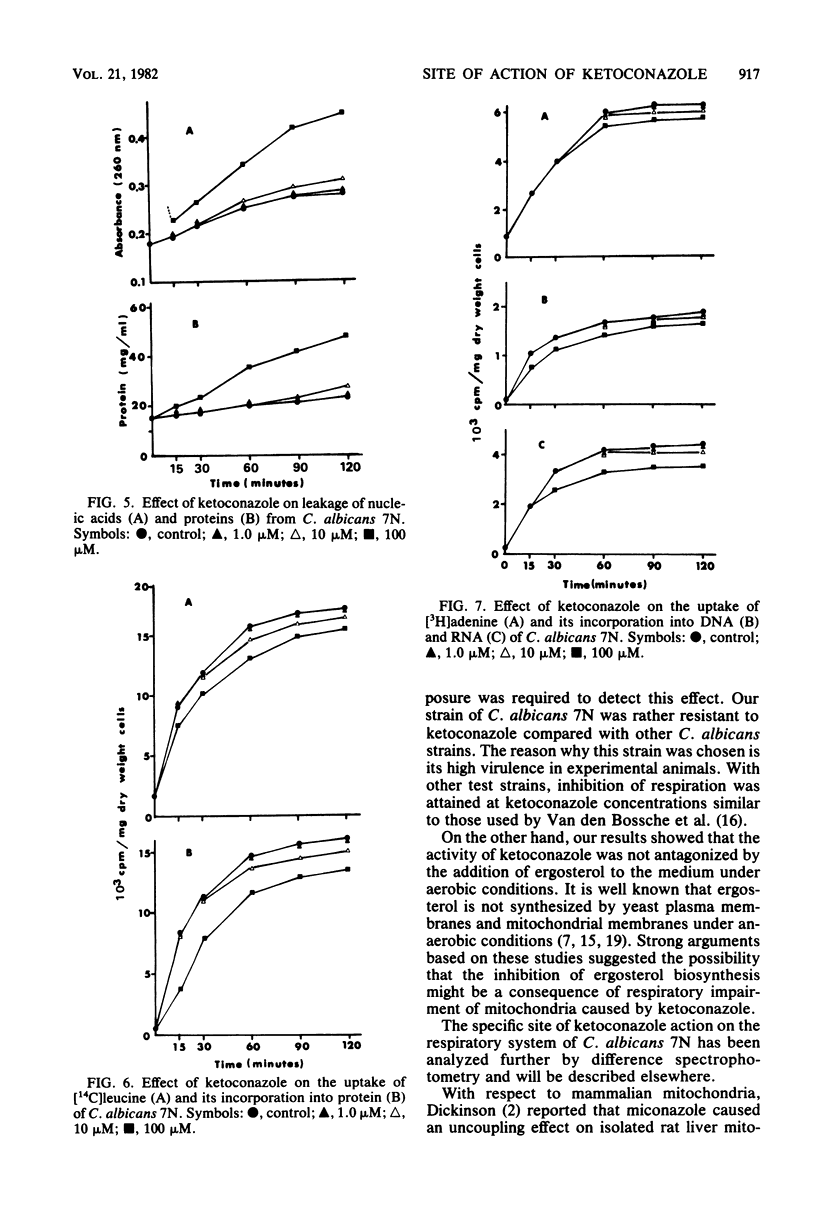

Images in this article
Selected References
These references are in PubMed. This may not be the complete list of references from this article.
- Dickinson D. P. The effects of miconazole on rat liver mitochondria. Biochem Pharmacol. 1977 Mar 15;26(6):541–542. doi: 10.1016/0006-2952(77)90331-8. [DOI] [PubMed] [Google Scholar]
- Iwata K., Kanda Y., Yamaguchi H., Osumi M. Electron microscopic studies on the mechanism of action of clotrimazole on Candida albicans. Sabouraudia. 1973 Nov;11(3):205–209. doi: 10.1080/00362177385190441. [DOI] [PubMed] [Google Scholar]
- Iwata K., Yamaguchi H. [Mechanism of action of clotrimazole. I. Study of the principal action on Candida albicans]. Nihon Saikingaku Zasshi. 1973 Nov;28(6):513–521. [PubMed] [Google Scholar]
- Jollow D., Kellerman G. M., Linnane A. W. The biogenesis of mitochondria. 3. The lipid composition of aerobically and anaerobically grown Saccharomyces cerevisiae as related to the membrane systems of the cells. J Cell Biol. 1968 May;37(2):221–230. doi: 10.1083/jcb.37.2.221. [DOI] [PMC free article] [PubMed] [Google Scholar]
- LOWRY O. H., ROSEBROUGH N. J., FARR A. L., RANDALL R. J. Protein measurement with the Folin phenol reagent. J Biol Chem. 1951 Nov;193(1):265–275. [PubMed] [Google Scholar]
- Marriott M. S. Inhibition of sterol biosynthesis in Candida albicans by imidazole-containing antifungals. J Gen Microbiol. 1980 Mar;117(1):253–255. doi: 10.1099/00221287-117-1-253. [DOI] [PubMed] [Google Scholar]
- Sreedhara Swamy K. H., Sirsi M., Ramananda Rao G. R. Studies on the mechanism of action of miconazole: effect of miconazole on respiration and cell permeability of Candida albicans. Antimicrob Agents Chemother. 1974 Apr;5(4):420–425. doi: 10.1128/aac.5.4.420. [DOI] [PMC free article] [PubMed] [Google Scholar]
- Sud I. J., Feingold D. S. Heterogeneity of action of mechanisms among antimycotic imidazoles. Antimicrob Agents Chemother. 1981 Jul;20(1):71–74. doi: 10.1128/aac.20.1.71. [DOI] [PMC free article] [PubMed] [Google Scholar]
- Swamy K. H., Joshi A., Rao G. R. Mechanism of action of miconazole: labilization of rat liver lysosomes in vitro by miconazole. Antimicrob Agents Chemother. 1976 Jun;9(6):903–907. doi: 10.1128/aac.9.6.903. [DOI] [PMC free article] [PubMed] [Google Scholar]
- Swamy K. H., Sirsi M., Rao G. R. Studies on the mechanism of action of miconazole- II. Interaction of miconazole with mammalian erythrocytes. Biochem Pharmacol. 1976 May 15;25(10):1145–1150. doi: 10.1016/0006-2952(76)90361-0. [DOI] [PubMed] [Google Scholar]
- Taketani S., Osumi T., Katsuki H. Characterization of sterol-ester hydrolase in Saccharomyces cerevisiae. Biochim Biophys Acta. 1978 Jul 7;525(1):87–92. doi: 10.1016/0005-2744(78)90202-4. [DOI] [PubMed] [Google Scholar]
- Van den Bossche H., Willemsens G., Cools W., Cornelissen F., Lauwers W. F., van Cutsem J. M. In vitro and in vivo effects of the antimycotic drug ketoconazole on sterol synthesis. Antimicrob Agents Chemother. 1980 Jun;17(6):922–928. doi: 10.1128/aac.17.6.922. [DOI] [PMC free article] [PubMed] [Google Scholar]
- Wallace P. G., Huang M., Linnane A. W. The biogenesis of mitochondria. II. The influence of medium composition on the cytology of anaerobically grown Saccharomyces cerevisiae. J Cell Biol. 1968 May;37(2):207–220. doi: 10.1083/jcb.37.2.207. [DOI] [PMC free article] [PubMed] [Google Scholar]
- Watson R., Yamazaki H. Alkali hydrolysis of RNA of Escherichia coli deposited on filter paper disks. Anal Biochem. 1973 Jan;51(1):312–314. doi: 10.1016/0003-2697(73)90479-x. [DOI] [PubMed] [Google Scholar]
- Yamaguchi H. Antagonistic action of lipid components of membranes from Candida albicans and various other lipids on two imidazole antimycotics, clotrimazole and miconazole. Antimicrob Agents Chemother. 1977 Jul;12(1):16–25. doi: 10.1128/aac.12.1.16. [DOI] [PMC free article] [PubMed] [Google Scholar]
- Yamaguchi H., Iwata K. [Mechanisl of action of clotrimazole. 2. Effects on the cell membrane of Candida albicans]. Nihon Saikingaku Zasshi. 1974 Mar;29(2):379–385. [PubMed] [Google Scholar]
- Yu F. L., Feigelson P. Paper disc estimation of radioactive RNA: studies on the presence and elimination of metabolically generated artifacts from labeled purine and pyrimidine precursors. Anal Biochem. 1971 Feb;39(2):319–321. doi: 10.1016/0003-2697(71)90420-9. [DOI] [PubMed] [Google Scholar]
- van den Bossche H., Willemsens G., Cools W., Lauwers W. F., Le Jeune L. Biochemical effects of miconazole on fungi. II. Inhibition of ergosterol biosynthesis in Candida albicans. Chem Biol Interact. 1978 Apr;21(1):59–78. doi: 10.1016/0009-2797(78)90068-6. [DOI] [PubMed] [Google Scholar]



